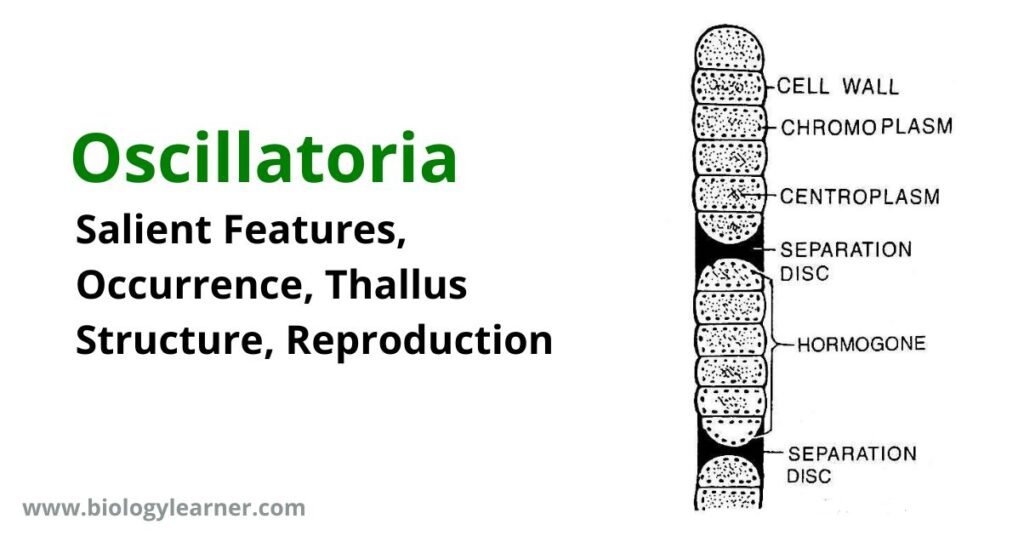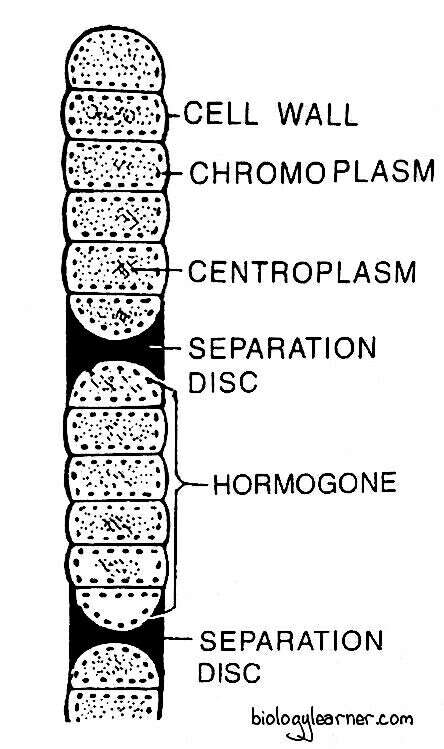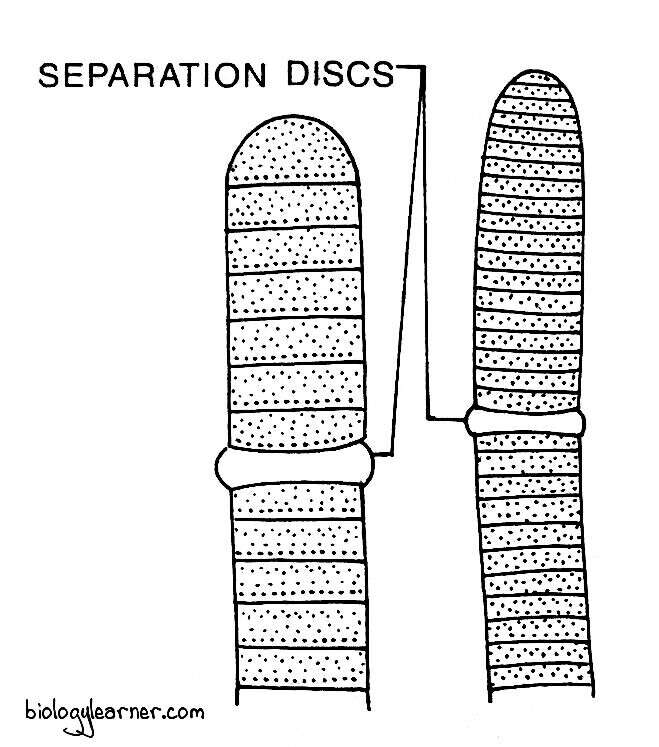Oscillatoria is a common genus of Cyanobacteria or blue-green algae. It often occurs in freshwater habitats.
Oscillatoria forms a thin, blue-green coating on the surface or edge of flowing water.
Salient Features of Oscillatoria
The salient features of Oscillatoria are as follows:
- The plant body is an unbranched filament. The filaments of Oscillatoria are called trichomes.
- The trichomes may be naked or surrounded by a thin, poorly developed mucilaginous sheath.
- Each trichome is uniseriate and consists of many closely arranged, uniform cells.
- The cells are usually more broad than long. Each cell can be differentiated into cell wall and protoplasm.
- Cells contain many pigments, such as chlorophyll-a, carotenes, xanthophylls, phycocyanin-c, and phycoerythrin-c, in the chromoplasm.
- Cyanophycean starch is the reserve food material.
- In most cases, growth takes place by amitotic division of intercalary cells of the trichomes.
- Oscillatoria shows various types of movements, such as gliding, oscillating, crawling, and bending.
- Reproduction occurs only through vegetative methods, such as fragmentation and hormogonium formation.

Read also- Nostoc: Salient Features, Occurrence, Thallus Structure, Reproduction
Occurrence of Oscillatoria
Oscillatoria is a genus of about 76 species in the family Oscillatoriaceae. It can be found in a wide variety of habitats, especially in places rich in organic materials.
Oscillatoria commonly occurs in rainwater pools, ponds, streams, and roadside ditches. It forms a bluish scam on the water surface or bottom of the very old ponds. Some species also grow on damp soil and rocks.
Oscillatoria prolifica is a planktonic species found in seawater, while O. terebriformis is a thermal alga that grows in hot water springs. Species like O. princeps occur in freshwater, seawater, or moist soil.
A few species are saprophytic and found in the digestive and respiratory tracts of animals.
Thallus Structure of Oscillatoria
The plant body of Oscillatoria is an unbranched, long, filamentous, thread-like structure. The filaments may be attached or remain free-floating. They rarely occur singly.
In most species, the filaments often form compact tangles or spongy sheets. Each unbranched filament of Oscillatoria is called a trichome.

The trichomes are not surrounded by a mucilaginous sheath and remain naked. Some species, such as O. formosa, they have a thin, poorly developed sheath.
The trichomes may be interwoven or arranged in parallel rows. They are generally smooth, sometimes constricted at the cross walls. Each trichome is composed of a row of closely arranged cells.
The cells are usually broader than their length. However, in species with narrow trichomes (e.g., O. splendida), the cells are cylindrical, and their length is equal to or greater than the breadth.
All the cells of the trichome are similar in shape, except the apical cell. The apical cell is variable in the form of different species and is usually round or dome-shaped. In some species (e.g., O. proboscidea), the apical cell is tipped with a thickened membrane called the calyptra.

In general, the apical portion of the trichome is hemispherical in most of the species of Oscillatoria. But the apex may be straight, bent like a sickle, or coiled more or less like a screw.
Cell Structure of Oscillatoria
The structure of all cells in the trichome is similar and typically cyanophycean. They are prokaryotic in nature. Each cell is differentiated into two parts: the cell wall and the protoplasm.
The cell wall is well developed and it is composed of mucopeptide. According to Halfen and Castenholtz (1970), the cell wall in O. princeps is ultrastructurally made up mainly of a thick structural layer external to the plasma membrane. The layer is about 200 Å thick.

There are two more layers present outside the structural layer. One layer has a thickness of 160 Å, and the other one is 90 Å thick. The third 90 Å layer (also known as the mucilage sheath) is loosely wrapped around the inner two. The structural layer contains a large number of pores. The pores are 700 Å wide and terminate at the 160 Å layer.
The protoplasm can be differentiated into a peripheral chromoplasm and a central colourless centroplasm, or central body.
The chromoplasm contains photosynthetic lamellae or thylakoids. The thylakoids are flattened sac-like structures and often run parallel to one another. Many photosynthetic pigments, such as chlorophyll a, carotenes, xanthophylls, and phycobilins (phycocyanin-C and phycoerythrin-C), are present in the thylakoids. The chromoplasm also contains cyanophycean starch, lipids, and cyanophycin granules as reserve foods.
The centroplasm represents only the incipient nucleus or nuclear body, called the gonophore. It consists of irregularly arranged DNA fibrils.

The cells lack membrane-bound cell organelles such as mitochondria, endoplasmic reticulum, plastids, and dictyosomes. However, small ribosomes are present.
Planktonic species of Oscillatoria possess gas vacuoles or pseudovacuoles in the protoplasm.
Reproduction in Oscillatoria
Oscillatoria reproduces only vegetatively. Sexual reproduction is absent.
The vegetative reproduction in Oscillatoria occurs through the following methods:
Fragmentation
Due to the accidental breakage or biting of some insects or animals, Oscillatoria filament can break into small fragments.
The broken fragments are capable of developing into new filaments.
Hormogonia
Under favourable conditions, hormogonia (also known as hormogones) are developed in the mature filaments. They are short segments of the trichome, which consists of a few cells.
In the trichome, some intercalary cells lose their protoplasm and die. These dead cells become biconcave and filled with mucilage. The mucilage-filled, pad-like dead cells are called necridia, or separation discs.

Due to the formation of necridia, the trichome may break into hormogonia (small multicellular fragments). Thus, hormogonia are present between the adjacent necridia.
When the trichome breaks at the necridia, the hormogonia are freely released into the water. Each hormogonium gives rise to a new Oscillatoria filament.
Taxonomic Position of Oscillatoria
According to Desikachary (1959);
| Class: | Cyanophyceae |
| Order: | Nostocales |
| Family: | Oscillatoriaceae |
| Genus: | Oscillatoria |



